Home › Forums › MGTD Kit Cars › My Project › Another project reported
- This topic has 224 replies, 22 voices, and was last updated 13 years, 4 months ago by
 ray10.
ray10.
-
AuthorPosts
-
April 3, 2012 at 8:10 am #244792
So the rope seal and the new style seal are not cross-compatible? One suspects that anything Rover did would have been more likely to leak oil, but I want to be sure.
Aluminum V8!! That is too cool.
April 3, 2012 at 8:39 am #244793I believe that this ’60’s model 215cu in General Motors V8 is the same one that was fitted into my brother’s TR6. They were lighter than many cast iron 4 cylinder engines. Is it fair to blame Rover for oil leaks? I think that chronic oil leaks and high production costs were the reasons that GM stopped making them and sold to Rover. Doesn’t GM deserve the rap?
April 3, 2012 at 1:38 pm #244794Anonymous
InactiveLots of stories about the BOP 215. This one is as good as any.From Wikipedia, the free encyclopediaBuick “Small-Block”In 1961, Buick unveiled an entirely new small V8 engine with aluminum cylinder heads and cylinder block. Lightweight and powerful, the aluminum V8 also spawned a turbocharged version, (only in the 1962-63 Oldsmobile Cutlass version), the first ever offered in a passenger car. It became the basis of a highly successful cast iron V6 engine, the Fireball. The all-aluminum V8 engine was dropped after the 1963 model year, but was replaced with very similar cast-iron block/aluminum head for one year, and then all iron, engines.
[edit] 215
- See also Rover V8 engine
GM experimented with aluminum engines starting in the early 1950s. Alcoa (Aluminum Company of America) was pushing all automakers to use more aluminum. An early development model was used in the 1951 Le Sabre concept car,[2] and the 1953 Buick Roadmaster concept car, and work on a production unit commenced in 1956. Originally intended for 180-cubic-inch (2.9 L) displacement, Buick was designated by GM as the engine design leader, and decided to begin with a larger, 215-cubic-inch (3.5 L) size, which was deemed ideal for the new “senior compact cars” introduced for the 1961 model year. This group of cars was commonly referred to as the “B-O-P” group ??? for Buick-Olds-Pontiac ??? or the Y-bodies.
Known variously as the Fireball and Skylark by Buick (and as Rockette, Cutlass, and Turbo-Rocket by Oldsmobile),[3] the 215 had a 4.24 in (108 mm) bore spacing, a bore of 3.5 in (89 mm), and a stroke of 2.8 in (71 mm), for an actual displacement of 215.5 cu in (3,531 cc). The engine was the lightest mass-production V8 in the world, with a dry weight of only 318 lb (144 kg). Measuring 28 in (71 cm) long, 26 in (66 cm) wide, and 27 in (69 cm) high (same as the small-block Chevy)[4] it was standard equipment in the 1961 Buick Special.
Oldsmobile and Pontiac also used the all-aluminum 215 on its mid-sized cars, the Oldsmobile F-85, Cutlass and Jetfire, and Pontiac Tempest and LeMans. Pontiac used the Buick version of the 215; Oldsmobile had its own. The Oldsmobile version of this engine, although sharing the same basic architecture, had cylinder heads and angled valve covers designed by Oldsmobile engineers to look like a traditional Olds V8, and was produced on a separate assembly line. Among the differences between the Oldsmobile from the Buick versions, it was somewhat heavier, at 350 lb (160 kg). The design differences were in the cylinder heads: Buick used a 5-bolt pattern around each cylinder where Oldsmobile went to a 6-bolt pattern. The 6th bolt was added to the intake manifold side of the head, one extra bolt for each cylinder, meant to alleviate a head-warping problem on high-compression versions. This meant that Oldsmobile heads would go on Buick blocks, but not vice versa. Changing the compression ratio on an Oldsmobile 215 required changing the heads, but on a Buick 215, only the pistons, which was less expensive and simpler. For that reason, the more common Buick version which looks like a traditional Buick vertical valve cover ‘nailhead’ V8 (but isn’t) has today also emerged as more desirable to some. But the Olds wedge shaped/quench combustion chambers/pistons are more compatible to modern low octane/low lead gasolines than the Buick ‘hemisperical’ shaped combustion chambers and domed pistons. Later Rover versions of the aluminum block and subsequent Buick iron small blocks (300 with aluminum, then iron heads, 340 and 350 with iron heads) went to a 4-bolt-per-cylinder pattern.
At introduction, Buick’s 215 was rated 150 hp (110 kW) at 4400 rpm. This was raised soon after introduction to 155 hp (116 kW) at 4600 rpm. 220 lb·ft (298 N·m) of torque was produced at 2400 rpm with a Rochester 2GC (DualJet) two-barrel carburetor and 8.8:1 compression ratio. A mid-year introduction was the Buick Special Skylark version, which had 10.00:1 compression and a four-barrel carburetor, raising output to 185 hp (138 kW) at 4800 rpm and 230 lb·ft (312 N·m) at 2800 rpm.
For 1962, the four-barrel engine increased the compression ratio to 10.25:1, raising it to 190 hp (140 kW) at 4800 rpm and 235 lb·ft (319 N·m) at 3000 rpm. The two-barrel engine was unchanged. For 1963, the four-barrel was bumped to 11:1 compression and an even 200 hp (150 kW) at 5000 rpm and 240 lb·ft (325 N·m) at 3200 rpm, a respectable 0.93 hp/cu in (56.6 hp/L).
Unfortunately, the great expense of the aluminum engine led to its cancellation after the 1963 model year. The engine had an abnormally high scrap ratio due to hidden block-casting porosity problems, which caused serious oil leaks. Another problem was clogged radiators from antifreeze mixtures incompatible with aluminum. It was said that one of the major problems was because they had to make extensive use of air gauging to check for casting leaks during the manufacturing process, and not being able to detect leaks on blocks that were as much as 95% complete. This raised the cost of complete engines to more than that of a comparable all cast-iron engine. Casting sealing technology was not advanced enough at that time to prevent the high scrap rates.
The Buick 215’s very high power-to-weight ratio made it immediately interesting for automotive and marine racing. Mickey Thompson entered a stock-block Buick 215-powered car in the 1962 Indianapolis 500. From 1946-1962, there hadn’t been a single stock-block car in this famous race. In 1962, the Buick 215 was the only non-Offenhauser powered entry in the field of 33 cars. Rookie driver Dan Gurney qualified eighth and raced well for 92 laps before retiring with transmission problems.
Surplus engine blocks of the Oldsmobile (6 bolt per cylinder) version of this engine formed the basis of the Australian Formula One Repco V8 used by Brabham to win the 1966 Formula One world championship. No other American stock-block engine has won a Formula One championship.
Rights to these engines were purchased by the British Rover Company and used in the 1967 Rover P5B that replaced the 3 L straight six Rover engined P5. Throughout the years, the Rover Co., which became part of British Leyland in 1968, and its successor companies constantly improved the engine making it much stronger and reliable. Capacities ranged from 3.5-5.0 L (215 to 307 in³). This engine was used for V8 versions of the MGB-GT known as the MGB GTV8. This came straight from the MG works at Abingdon-on-the-Thames. Rover also used the engine in the 1970 Range Rover which saw the engine successfully returning to the USA after the Range Rover’s 1986 introduction. U.S. Buick 215s have also been engine swapped into countless other platforms, especially Chevrolet Vegas and later British cars MG sports cars including the MG RV8 in the 1990s. Triumph TR-8, and various sports sedans and sports cars by the MG Rover Group and some specialist manufacturers such as TVR and the Morgan Motor Company. The engine remains well supported by enthusiast clubs, specialist parts suppliers, and by shops that specialise in conversions and tuning.
The 215 was also used in the Italian-American gran turismo Apollo in 1962-1963, as well as in the Asardo 3500 GM-S show car.
Although dropped by GM in 1963, the Rover V8 engine would remain in production use for more than another 39 years, even longer on the aftermarket. GM tried to buy it back later on, but Rover declined, instead offering to sell engines back to GM. GM refused this offer.
In the mid-1980s, hot rodders discovered the 215 could be stretched to as much as 305 cu in (5 l), using the Buick 300 crankshaft, new cylinder sleeves, and an assortment of non-Buick parts.[5] It could also be fitted with high-compression cylinder heads from the Morgan Plus 8. Using the 5 liter Rover block and crankshaft, a maximum displacement of 317.8 cu in (5,208 cc) is theoretically possible.[6]
April 3, 2012 at 1:45 pm #244795Anonymous
InactiveHistory of ROVER V8
From Wikipedia, the free encyclopedia
The Rover V8 began life as the Buick 215, an all-aluminium engine introduced in 1960 for the 1961 US model year. The compact engine was lightweight, at just 144 kg (318 lb), and capable of high power outputs: the most powerful Buick version of this engine rated 149 kW (200 hp), and the very similar Oldsmobile “Jetfire” turbocharged version made 215 hp (both numbers SAE gross). Based on sales volume and press reports, the engine was a success. Buick produced 376,799 cars with this engine in just three years. A comparable number of Oldsmobile 215 engines were produced. In addition, some Pontiac models were fitted with the Buick 215, leading to the nickname “BOP 215” for the engine (BOP standing for Buick/Oldsmobile/Pontiac). The aluminium engine was relatively expensive to produce, however, and it suffered problems with oil and coolant sealing, as well as with radiator clogging from use of antifreeze incompatible with aluminium. As a result, GM ceased production of the all-aluminium engine after 1963, although Buick retained a similar iron engine[1964-1980], as well as a V6 derivative[1962-2008] which proved to have a very long and successful life.[clarification needed]In January 1964 Rover gave American operations head J. Bruce McWilliams permission to investigate the possible purchase of an American V8 engine for Rover cars. It is usually said that McWilliams first saw the Buick V8 at the works of Mercury Marine, where he was discussing the sale of Rover gas turbines and diesel engines to the company (Mercury did indeed use the Land Rover diesel engine in marinised form). However, it seems likely that McWilliams was aware of the Buick engine before this. In any case, McWilliams realised that the lightweight Buick V8 would be ideal for smaller British cars (indeed, it weighed less than many straight-4 engines it would replace.) McWilliams and William Martin-Hurst began an aggressive campaign to convince GM to sell the tooling, which they finally agreed to do in January 1965. Retiring Buick engineer Joe Turlay moved to the UK to act as a consultant.
As well as appearing in Rover cars, the engine was widely sold by Rover to small car builders, and has appeared in a wide variety of vehicles. Rover V8s feature in some models from Morgan, TVR, Triumph, Land Rover and MG, among many others. The first use of the engine by a UK maker was actually Warwick who fitted the engine, purchased directly from Buick, to the stillborn Warwick 305GT.[2] They have even been used in light aircraft due to their light weight and high power output.
The Rover V8 has long been a relatively common engine for kit car and hot rod use in Britain, much as the Chevrolet small-block V8 is for American builders (though many British hot rods have traditionally used four cylinder engines, like the Ford Pinto and Crossflow units). Even in the US there is a strong contingent of builders who select the Buick or Rover aluminium V8 engine for use in small sporty cars like the MG MGB and the Chevy Vega. Note also that the 1964 Buick iron-block 4,920 cc (300 cu in) engine had aluminium cylinder heads and a longer stroke crankshaft which with minor modifications can be used with the Buick 215 or Rover engine blocks to produce a high output, very light weight V8 with displacement of up to about 300 cubic inches. The 300 crank in the 215 block yields 4,260 cc (260 cu in).
The British made engines were run on two SU carburettors (14 years), then two Stromberg carburettors (2-3 years), Bosch L-Jetronic (7-8 years, a.k.a. Lucas 4CU Flapper), then Hitachi Hotwire (5 years, a.k.a. Lucas 14CUX), then the GEMS system (years) and finally Bosch Motronics for 2 years. The engine is still cast now (2011), in an improved version, by Coscast in Birmingham, UK.
The demise of the MG Rover Group in 2005 led to a halt in production of the famed “name” Rover V8 after 40 years. The last Rover to have a real Rover V8 was the Rover SD1 Vitesse which was replaced by the Rover 827 Vitesse with a 2.7 litre Honda V6 unit, The Rover V8 remained with Land Rover until being sold to Ford by BMW. However, Land Rover desired for production of the engine to continue, and they arranged for production to restart in Weston-super-Mare under MCT, an engineering and manufacturing company. Although Land Rover has switched to the Jaguar AJ-V8 engine for new applications, MCT will continue limited production of the engine for the indeterminate future, supplying engines for aftermarket and replacement use.[3]
It is also interesting to note that the “Rover V8” based on the Buick design was not the first V8 produced by Rover. When the Rover Co was having engineering differences of opinion with the development of the Whittle turbine engine, the Wilks’ did a deal with Rolls-Royce to swap technologies. The turbine engine project went to Rolls-Royce and Rover Co took over the V12 Meteor production used in the Centurion Tank. From this a V8 variant was developed the Rover Meteorite, also known as Rolls-Royce Meteorite, was a V8 petrol engine of 18.01 L (1,099 cu in) capacity. In essence it was two-thirds of a V12 Meteor, and it shared the Meteor’s 60° bank angle. Meteorites were built for vehicles, for marine use and as stationary power units.
It powered the Thornycroft Antar or Mighty Antar Tank Transporter, so was used to transport Meteor-engined tanks, and also heavy transport on the Snowy Mountains Hydro-Electric Scheme in Australia.
[edit] Racing
As the aluminium block made this engine one of the lightest stock V8s built, it was an obvious choice for use in racing. Mickey Thompson entered a car powered by this engine in the 1962 Indianapolis 500. From 1946 to 1962 there had not been a single stock-block car entered in this famous race. In 1962 the Buick 215 was the only non-Offenhauser powered entry in the field of 33 cars. Rookie driver Dan Gurney qualified eighth and raced well for 92 laps before retiring with transmission problems.
The Australian firm Repco converted this engine for Formula One by reducing its stroke to some 61 mm (2.4 in) to give 3 L (180 cu in) and fitting a single overhead camshaft per bank rather than the shared pushrod arrangement. Conrods from the Daimler 2,548 cc V8 were used. Repco-powered Brabhams won the F1 championship twice, in 1966 and 1967.[4] For the 1968 season, the Repco engine was fitted with new four-valve, dual overhead camshaft heads. This made the engine roughly as powerful as the Cosworth DFV, but proved to be too much for the stock block, which broke on many occasions. Repco also experimented with 4.2 L (260 cu in) derivatives of the Rover V8, to some success despite problems with massive vibration.[5]
The Rover version of this engine was extensively developed and used for rally racing, especially in Triumph TR8 sports cars.
April 3, 2012 at 1:57 pm #244796Anonymous
InactiveEd — I believe the block can be machined to take the modern seal. Guess that might be a good choice to look into in the future.
Royal–My neighbor is from England and is a car guy. He has 3 Rovers, a TR, Morris, Jag and his DD, a Ford P/u. In England if you do a V8 its most probably Rover based. My mock up engine is a Rover that was scrapped because the iron cylinder liner slipped. It was very soon after a rebuild and surely a big disappointment to the owner. The story is hereOne of the reasons to pick this engine besides it small size, light weight, vintage years is the fact the MGB community is putting them in their cars. This makes for lots of parts and info. Also there is the name brand connection.Off to get the rope seal “just right”April 3, 2012 at 2:22 pm #244797Scott, They are pretty engines and I like the size and weight. Also, many moons ago, I helped a friend put a 60hp Ford V8 into a MGTD (his idea, not mine). Installation was not easy but it looked great once installed. They too, are pretty little engines. BUT very heavy. “Drove like a truck.” He promptly sold it.
April 3, 2012 at 8:48 pm #244798Anonymous
Inactive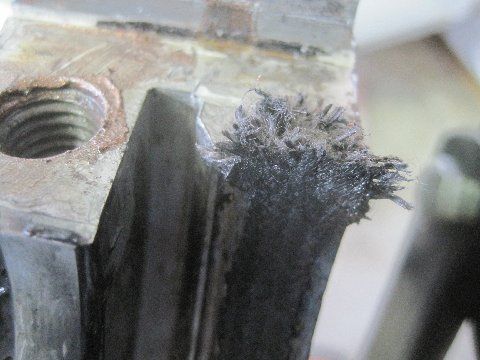
The end of the rope seal was supposed to be flush or 1/16″ proud of the mating surface. Since it was down in a recess and needed to be placed before cut it took a bit of time. Certainly anyone who had experience with rope seals would of had a quick and easy time.
April 3, 2012 at 8:53 pm #244799Anonymous
Inactive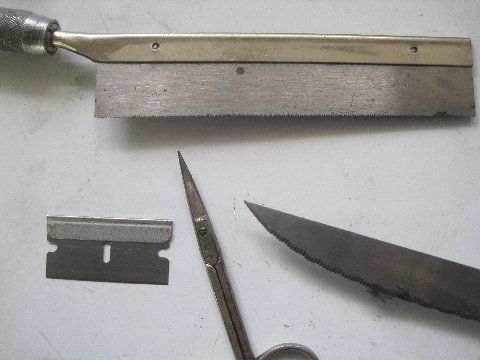
Some of the weapons tried during battle. The scissors did the trick best. Again the Magnifocuser was a real help.
In the excitement the finished product got away un-photographed and its not coming apart again for that.April 3, 2012 at 8:56 pm #244800Anonymous
Inactive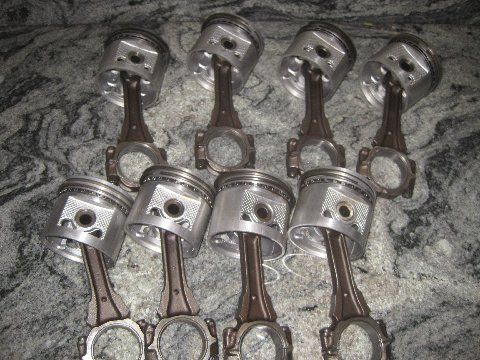
Next up, these will slide into their holes. Arrows pointing forward and con rod squirting holes pointed up.
April 11, 2012 at 4:56 pm #244801Anonymous
InactiveWell the pistons fell into their holes. The con rod caps are torqued, the rings are spaced, the piston arrows facing forward. Guess its time to put the heads on. This video
covers the procedure approximately so you can take a look. Using the ARP head studs instead of bolts is recommended by most all Buick/Rover builders.
Assembling the engine is freeing up some space. Can’t wait to assemble the body parts and really get some room back!April 12, 2012 at 10:56 pm #244802Anonymous
Inactive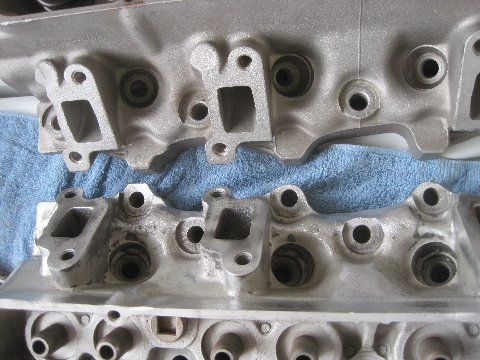
Todays puzzle. Was short some holes to put bolts in. After a good deal of head scratching it turrns out the heads I was using are Rover and only have 4 bolts per cylinder instead of 5 like Buick. D & D said they could be used but not the best choice.
April 12, 2012 at 10:59 pm #244803Anonymous
Inactive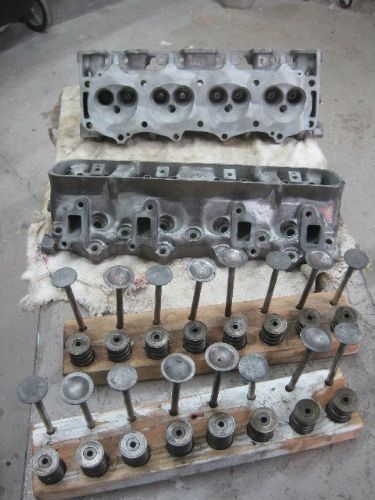 So back to the shop and assembled a Buick pair.April 12, 2012 at 11:02 pm #244804
So back to the shop and assembled a Buick pair.April 12, 2012 at 11:02 pm #244804Anonymous
Inactive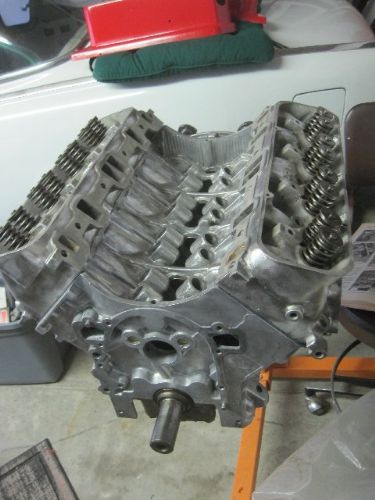 Took a little longer this way but now its ready for bolting down.April 13, 2012 at 8:21 am #244805
Took a little longer this way but now its ready for bolting down.April 13, 2012 at 8:21 am #244805Bolts? Or ARP studs?
April 13, 2012 at 8:58 am #244806Nice. A little bigger than the VW 1600 I’m rebuilding
rockyx2012-04-13 08:59:31
April 13, 2012 at 9:16 pm #244807Anonymous
InactiveEd– You be right. ARP studs for sure. In and torqued today. Cam placed. Lifters and valve train up and coming!
April 14, 2012 at 1:15 am #244808Anonymous
InactiveRocky- It works out that the 215 cu inch buick is just a little over double the VW @ 3523 cc. Your gas mileage might be double!
April 14, 2012 at 8:23 pm #244809Anonymous
InactiveTodays lesson. There is a top and bottom to valve springs. You can tell the bottom, it has close spaced coils. You tell me now that the heads are on and torqued down.
Life is about choices. Heads could come off. Could buy or rent the valve compressor that can be used on an assembled engine. Or I can build something. No brainer for me I love challenges and building tools. Get some ideas from Google, Amazon and Youtube and off to the shop.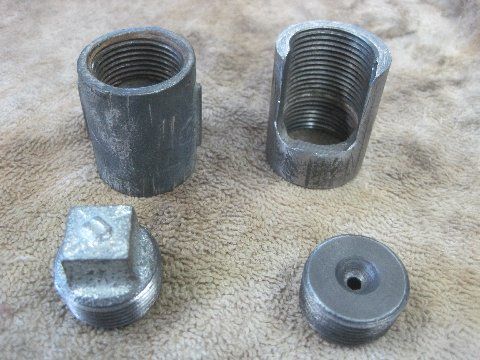 These are standard pipe fittings. The two on the left are as found and the two on the right are modified. The coupler has been notched for access to the valve keepers. The cap has been counersunk to provide a bearing surface for the screw. Hopefully this will be self explanatory with the coming pictures.April 14, 2012 at 8:24 pm #244810
These are standard pipe fittings. The two on the left are as found and the two on the right are modified. The coupler has been notched for access to the valve keepers. The cap has been counersunk to provide a bearing surface for the screw. Hopefully this will be self explanatory with the coming pictures.April 14, 2012 at 8:24 pm #244810Anonymous
Inactive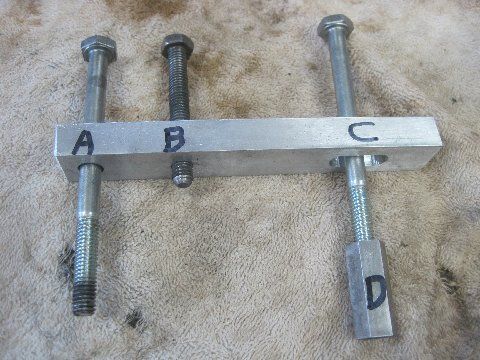 April 14, 2012 at 8:30 pm #244811
April 14, 2012 at 8:30 pm #244811Anonymous
InactiveThis is an aluminum bar. Its 1/2″ x1″ x 7″ long. Hole A is a clearance hole for a 3/8 bolt. Hole B is threaded 3/8-16. Hole C is slotted for adjustment for a 3/8 bolt. If you meausre carefully it probably wouldn’t need slotted. Extention Nut D was redrilled and tapped on one end for 7/16-20. The other end fits the 3/8 bolt.
April 14, 2012 at 8:31 pm #244812Anonymous
Inactive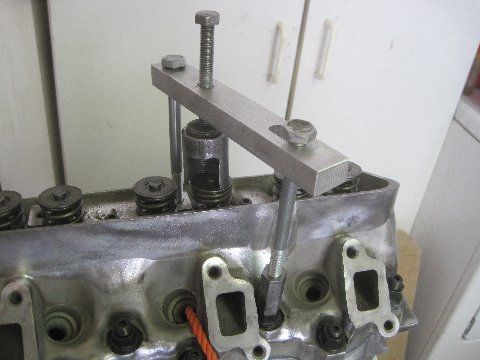 April 14, 2012 at 8:36 pm #244813
April 14, 2012 at 8:36 pm #244813Anonymous
InactiveHere is the assembled product.
First the old rope trick. That orange rope is going down the spark plug hole to fill up the cylinder. The idea is to keep the valve from falling into the cylinder. When the spring and keepers are removed it could.Another way of doing this is with air pressure. Make or buy a fitting that threads into the spark plug hole and attaches to compressed air source. Air pressure will keep the valves in place.April 14, 2012 at 8:55 pm #244814Anonymous
Inactive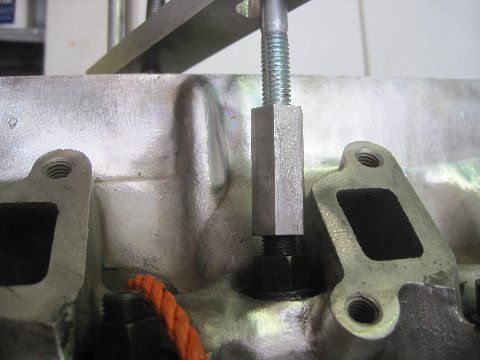 This shows how the modified D nut attaches to the ARP head stud.April 14, 2012 at 9:14 pm #244815
This shows how the modified D nut attaches to the ARP head stud.April 14, 2012 at 9:14 pm #244815Anonymous
Inactive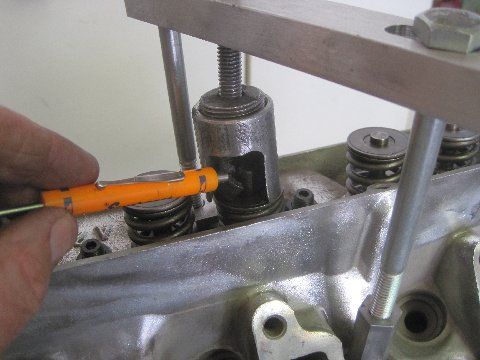 Bolt A and C with the aluminum bar form a frame. The bolt B that goes thru the threaded hole is used to compress the valve spring. The modified pipe fitting is placed on top of the valve spring and bolt B is screwed down. The notch in the fitting gives access to the valve keepers. When the spring is compressed the valve keepers can be reached with a magnet.July 28, 2012 at 12:02 am #244816
Bolt A and C with the aluminum bar form a frame. The bolt B that goes thru the threaded hole is used to compress the valve spring. The modified pipe fitting is placed on top of the valve spring and bolt B is screwed down. The notch in the fitting gives access to the valve keepers. When the spring is compressed the valve keepers can be reached with a magnet.July 28, 2012 at 12:02 am #244816Scott
how is your project coming along ,Also I was wondering what you thought of the interlux paint that you used ?
TDREPLICA Map
http://www.arcgis.com/home/webmap/viewer.html?webmap=7f9174ad614e43b680deba085b0abf48
-
AuthorPosts
- You must be logged in to reply to this topic.
